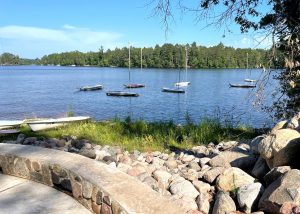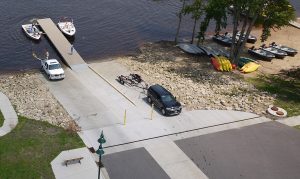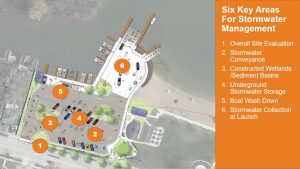Lurking within marinas and other waterfront landscapes are a handful of frequently unnoticed yet widely polluting particles that pose a threat to the quality of our water.
Total Suspended Solids (TSS) are a category of undissolved particles larger than 2 microns in size and identified by the U.S. Clean Water Act as pollutants. TSS can be natural or man-made — the result of runoff from impervious hardscapes such as buildings, roofs, roads, and parking lots — and include things like sand, gravel, silt, clay, salt, oils, and garbage. High levels of TSS can adversely affect the integrity of our water resources by decreasing water’s natural dissolved oxygen levels, increasing overall water temperature, and accelerating water’s turbidity or cloudiness — which in return — blocks sunlight, stunts photosynthesis, and poses a threat to aquatic ecosystems. Salt is a particular concern in wintery climates, especially when snow is plowed and stockpiled near water sources. All that collective motor oil, salt, and wintery gunk is slowly polluting our freshwater and groundwater — killing off freshwater fish species and contaminating aquatic life. The solution?
Stormwater Best Management Practices
Successful stormwater management utilizes a holistic system approach. Best management practices (BMPs) are part of this holistic approach — methods that have been recognized as the most effective, efficient means of reducing or preventing pollution in urban and natural environments. There are a variety of recommendations and approaches to consider, yet marinas and waterfront facilities are best served by developing stormwater BMPs specific to their unique situation and environmental inputs.
That said, we suggest five key opportunities for stormwater management, with some project-specific examples of what has worked for various clients and ideas for what types of solutions are available for today’s marina market.
Five Opportunities for Stormwater Management
- Site Studies
Whether assessing an existing marina for stormwater upgrades or considering a new development altogether, conducting a thorough site evaluation is a critical first step. This includes reviewing existing topographic maps of the property or having a professional surveyor create a new one. The study inventories how surface water flows throughout the landscape, where potential stormwater pollutants are located, where pollutants may mix with stormwater, and where stormwater drains or discharges. Does all stormwater drain into the lake or river? Is it properly collected and treated prior? Doing some basic investigation and observation will expose areas of concern — and opportunities for mitigation.
A thorough site study will also assess five key areas: the location of buildings and permanent structures; paved areas, including roads and access routes; stormwater drainage patterns and conveyances; locations where potential pollutants are used, stored, or located; and locations where “industrial” types of activities occur. It will also review the overall site climate, tilt or slope, size, and overall effectiveness for stormwater conveyance and existing treatments.
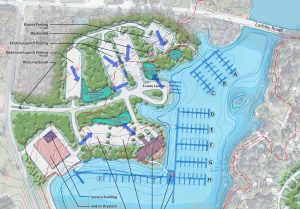
Stormwater Plan for the Seneca Marina as part of the Muskingum Watershed Conservation District, Ohio.
2. Stormwater Conveyance
Here, we dive a bit deeper into exactly how stormwater travels, where the site’s runoff zones and slopes are, and what opportunities are present for storm collection. It is helpful to evaluate the overall grade and slope of a marina property. Does the site tilt toward or away from the waterfront? How are parking areas graded? If the site is intrinsically leaning toward the shoreline, then all runoff — TSS included — is being directly funneled into the water. In these situations, marinas should consider either re-grading and modifying the tilt of their landscape or implementing collection zones throughout the property to capture and treat stormwater before it enters the waterway.
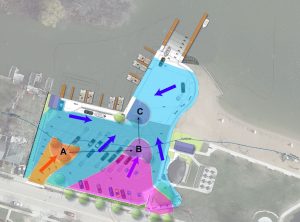
Proposed stormwater conveyance plan for the Lac La Belle Boat Launch in Oconomowoc, WI.
3. Collection & Infiltration Systems
There are a variety of stormwater collection and treatment systems that marinas and waterfront facilities can consider implementing. Options vary in shape and size and can be an excellent aesthetic enhancement to any property — the perfect blend of form and function. Some examples are constructed wetlands or sediment basins, rain gardens and bioretention areas, vegetated swales, forebays, and engineered treatment systems.
Constructed Wetlands – utilize the same natural processes that occur in the wild except that they are designed and placed precisely where a property needs stormwater collection most. In these areas, a combination of wetland vegetation, soils, and microbial properties filter sediments and pollution to help improve water quality on its way to receiving lakes and rivers.
Rain Gardens – are relatively shallow depressions in the ground planted with native vegetation to capture and filter stormwater runoff. Rain gardens also excel at preventing erosion by establishing deep roots that hold soil in place and are a cost-effective (and beautiful) means to introduce perennial plants and attract birds while reducing runoff. Bioretention areas are similar to rain gardens but much more engineered, typically consisting of an underdrain with gravel bed and engineered soils to promote infiltration of the treated stormwater.
Project Spotlight: Camp Manito-wish YMCA Shoreline & Drainage Improvements – Boulder Junction, WI
This shoreline restoration project at Camp Manito-wish YMCA addressed an eroding shoreline and walkway, which was replaced with an expanded, accessible walk and ramp connection at the top of the adjacent bluff. Runoff from the bluff, lake-edge buildings, new concrete walks, and launch are now collected in multiple rain gardens prior to entering the pristine waters of Boulder Lake. Native northern Wisconsin shoreline vegetation was placed as planting plugs in the rain gardens and the project also included a new bio-revetment shoreline. The photo below shows the first year’s growth within this successful stormwater system.
Rain gardens at Camp Manito-wish in Mequon, WI.
Vegetated swales or Bioswales – are shallow, open channels that help slow and filter surface runoff through thick grasses that slow the water and settle out pollutants. They are intentionally designed and contoured linear systems most frequently integrated into parking lots areas or along roadway medians. In areas with permeable soils, runoff nicely infiltrates into the soil beneath; in areas that are less permeable, swales can be constructed with engineered media beneath that helps channel runoff into an underdrain area where it is treated.
Forebays – are small, engineered basins for collecting and filtering TSS before it enters a water body. They function very much like rain gardens — living, growing, wetland-like features with native plants whose deep roots “clean” contaminants through a combination of microbial action in the soil, vegetative uptake, evaporation, and slowing water to allow settlement. The most effective design is a series of forebays set to drain from one into the other/s, progressively treating in sequence until ultimately discharging into the nearby river or lake. Forebays are constructed by excavating a basin or depression, lining the bottom with stone (in some cases sand mix) and topping with soil and native wetland vegetation. These basins can also serve as attractive vegetated features improving site appearance and ambiance.
Engineered Treatment Systems – There are some outstanding engineered treatment options on today’s market as well, such as below-ground systems like Vortechs® by Contech Engineered Solutions. These can be found in localized municipal stormwater networks but can be an excellent addition to marina infrastructure, particularly for sites needing shallow treatment due to bedrock, groundwater restrictions, or conflicting utilities.
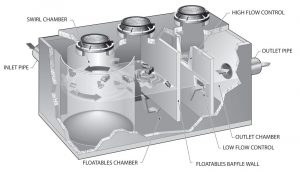
Diagram for a Vortechs treatment system.
Vortechs is an aluminum cylinder that acts — as the name suggests — like a vortex. Water enters the chamber through an inlet where the mechanized swirling motion promotes gravitational separation of sediments which then settle and accumulate on the chamber floor. The system is designed to treat sediment, trash debris, hydrocarbons, and stormwater runoff, which are either filtered out or trapped by an interior baffle wall while treated stormwater exits via an outlet pipe. The resulting debris and sediment can then easily be extracted through a manhole access by a vacuum truck with little hassle.
Project Spotlight: Newport Park – Lake Delton, WI
The boat launch at Newport Park is designed to slope to the left as shown in the photo, allowing water to be directed to curb inlets. All the remaining runoff and water from boats coming out of the river is collected in a linear trench drain at the edge of the concrete launch. The water from both collect points is directed into the underground Vortech system for treatment, easily accessed by two ground-level manholes for clean-out.
Stormwater collection system at Newport Park Boat Launch in Lake Delton, WI.
4. Storage Systems
The most traditional way to store stormwater runoff on site is in the form of basins or ponds — either detention or retention. Detention ponds are designed to store water temporarily and release it bit by bit until the pond is drained. As such they are dry most of the time, employed mainly after storm events. Retention ponds, on the other hand, are meant to permanently hold runoff and regulate water levels through an outlet or spillway feature.
However, both types of storage systems require real estate — often more space than marinas have on hand. Fortunately, there are other excellent storage options for marinas of all shapes and sizes.
Underground storage chambers accept, treat, and discharge runoff while being largely out of sight and out of mind. They are also an excellent solution for marinas or waterfront facilities with smaller footprints — where things like wetlands, rain gardens or forebays are not an option. Underground storage systems can be constructed of materials such as metal or plastic (PVC) and can be designed as components linked or welded together in one large flow-through matrix or as a stacked system. The larger the size, the greater the detention capacity. These systems typically have vertical inlet pipes to collect stormwater runoff and horizontal outlet pipes to discharge. The bottom of the system can also be open or with permeable features to promote filtration of the runoff into the surrounding soil.
Project Spotlight: Lac La Belle Boat Launch – Oconomowoc, WI
Lac La Belle spans 1,154 acres in the City of Oconomowoc — located approximately 30 miles west of Milwaukee. The community had been rallying for an updated boat launch for some time, with the goal of incorporating upgrades to the launch with neighboring City Beach Park to improve site flow, safety, accessibility, and stormwater management.
Proposed approach to stormwater management at Lac La Belle Boat Launch in Oconomowoc, WI.
One challenge of the existing launch is its relatively low elevation. The floodplain line actually bisects the parking lot, making it inaccessible during high-water events and requiring new stormwater collection and storage practices to achieve stormwater BMP compliance. The site also currently slopes toward the lake, meaning that all runoff and associated TSS is funneled directly into Lac La Belle.
MSA designed a variety of boat launch upgrades to address these challenges and more, including utilizing fill to raise the elevation of the shoreline area, constructing three new wetland/sediment basin areas, and re-grading the site to drain into those new collection systems rather than into the lake. The site also needed a new system to collect, store and treat stormwater as well as lake water during high-water events, so MSA stormwater engineers and hydraulic modelers determined the right size and elevation for a new underground storage system. Constructed of large-diameter corrugated metal piping that is welded together, the 8,750 cubic feet of underground storage will be placed so that when the lake level rises, water backs up into the drainage system where it is stored until the lake recedes — after which, it is slowly released over hours of time — allowing sediments to settle out and reducing any adverse impacts of a quick release (shoreline erosion that would have occurred due to site modifications) without mitigation practices in place.
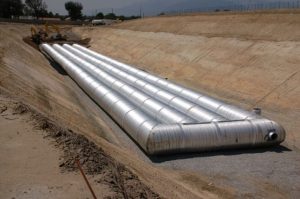
Underground stormwater storage system at Lac La Belle Boat Launch in Oconomowoc, WI.
5. Green Engineering and Stormwater Aesthetics
Stormwater systems offer great opportunity to enhance the entire marina ecosystem, design more resilient public spaces, and improve site aesthetics. A professional landscape architect can be of great help in pairing open-space and shoreline improvements with stormwater amenities in a constructive and creative manner. Done right, these types of enhancements help filter stormwater, prevent erosion, stabilize shorelines, improve water quality, and attract wildlife.
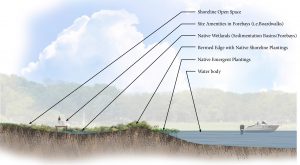
Green stormwater treatment options.
Green stormwater treatments can begin in upland areas with the development of shoreline open spaces, rain gardens and forebays, which can be enhanced with boardwalks, educational signage, or art. Native plantings can follow the progression to the water as well, with species conducive to the full spectrum of marine environments. For lawns and upland areas, any number of native perennials or grasses selected for the right growing zone will lend flourishes of color, texture, and appeal year after year with very little ongoing maintenance. Wet meadow emergent plants are a good choice for the bermed edges of detention basins or forebays, while deep marsh plant varietals are excellent semi-submerged or at the water’s edge.
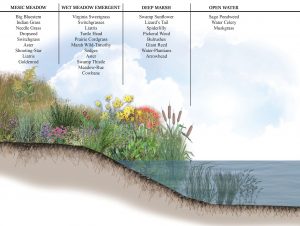
Emergent and native planting options for waterfronts.
Conclusion
By implementing site-specific Stormwater Best Management Practices through information gathered from site data collection, green engineering solutions, and well-designed collection and treatment systems, the adverse impacts of Total Suspended Solids can be turned from a regulatory necessity into a site asset. Both functionally important and aesthetically pleasing, stormwater upgrades help ensure we remain responsible stewards of our water resources and preserve or improve our recreational waters for future generations.
This article was first published in the May-June 2024 issue of Marina Dock Age Magazine.
